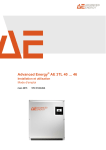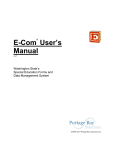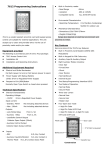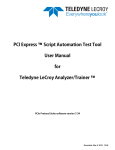Download Multifamily Charging Station Installation Handbook
Transcript
MULTIFAMILY HOUSING CHARGING STATION INSTALLATION HANDBOOK Version 4.0 MULTIFAMILY CHARGING STATION INSTALLATION HANDBOOK Version 4.0 This handbook was made possible through the support of Duke Energy, the North Carolina Electric Membership Corporation, Dominion North Carolina Power, and the NC PEV Taskforce working group on Multifamily Housing and Electric Vehicles. NC PEV Taskforce Multifamily Housing Working Group Members 2 Representative Organization Allegre Peav y Allister North Hills Apartments Bill Eaker Land of Sky Clean Vehicles Coalition Burwell Stark Triangle Apartment Association Cindy Keene Duke Energy Cornelius Willingham Nissan North America Emily Barrett Town of Cary Jason Wager Centralina COG/ Centralina Clean Fuels Coalition Jennifer Satterthwaite Palmetto State Clean Fuels Coalition Jin Park Schneider Electric Ken Szymanski NC Apartment Association Maggie Leslie Western North Carolina Green Building Council Marcy Bauer NC Clean Energy Technology Center Mike Waters Duke Energy Prince John Gaither- Eli City of Greensboro Rick Schroeder North Carolina's Electric Cooperatives Sam Watson NC Utilities Commission Sarah Bruce Triangle J COG/Triangle Clean Cities Coalition Stan Cross Brightfield Transportation Solutions Tom Adamich Wells Fargo Multi-Family Charging Station Installation Handbook Version 4.0 DRIVING THE FUTURE OF TRANSPORTATION Advanced Energy is working to assist utilities, charging station vendors, municipalities and all stakeholders in understanding, planning for and NC PEVTaskforce implementing electric transportation initiatives. As your trusted resource for advancing electric transportation, we can assist you in creating a strong foundation for successful change through: yy Consulting and Planning yy Technical Evaluation yy Education and Outreach Our day-to-day means of transportation is changing, and the more communities and consumers know about Plug-in Electric Vehicles (PEVs), the more prepared they will be to embrace them. This handbook has been developed to assist in assessing your options for vehicle charging at a multifamily home. For more than 10 years, Advanced Energy has been collaborating with stakeholders across the United States on PEV technologies and initiatives. We share our expertise with you to simplify the integration of electric transportation into your community. Advanced Energy works with North Carolina Stakeholders to promote PEV readiness through the NC PEV Taskforce. Guidance for this document was provided by members of the NC PEV Taskforce Working Group for Multifamily Housing and Electric Vehicles. To learn more, please visit www.advancedenergy.org and www.NCPEVTaskforce.org. ©2014 Advanced Energy 3 CONTENTS Driving the Future of Transportation 3 Step 2: Equipment Selection 27 Multifamily Housing and Electric Vehicles 5 29 Plug-In Electric Vehicles 101 6 Step 3: Installation 30 Charging 101 8 Electrical Work and Inspection 31 Charging Cycle 11 Electrical Upgrades 33 Why Drive Electric? 12 Installation Process Checklist 34 Benefits to Property Owners/Managers 13 Other Considerations 35 Multfamily Challenge #1: Shared and Public Parking 15 Appendix A: Americans with Disabilities Act 36 Multfamily Challenge #2: Restricted Utility Access 16 Appendix B: Encroachment Agreements 46 Multfamily Challenge #3: Complex Metering 17 Glossary48 Multifamily Installations 18 Why Advanced Energy? Multifamily Installation – Process Overview 19 Step 1: Assessing Your Charging Options 20 Parking Locations 21 Charging Station Locations 22 Garage 22 Carport/Driveway 23 Parking Decks 24 Parking Lots 25 On-Street Parking 26 4 Equipment Selection Worksheet 49 Multi-Family Charging Station Installation Handbook Version 4.0 MULTIFAMILY HOUSING AND ELECTRIC VEHICLES Electric vehicles are growing rapidly in the United States and North Carolina. These vehicles are fueled through electricity and allow the driver to refuel at home through the use of an outlet. This can be difficult if the driver is living in a multifamily community, especially when designated outlets, parking spots and electric meters are not available. This handbook will introduce you to electric vehicles and charging options, and detail the steps that need to be taken in order to provide electric vehicle charging to residents. Multifamily Housing U.S Housing Market Multifamily housing 17.1% North Caroilna Housing Multifamily housing is a classification of residential housing where multiple housing units are contained within one building or several buildings with a community. Some multifamily residences are owned as condominiums, where one or more Multifamily housing units are owned individually rather than leased from a single building owner. Some common types of multifamily housing are duplexes, townhomes and apartments. All are similar to single-family housing in terms of time-of-day charging and general power requirements, but installation requirements 25.9% United States Housing may be more similar to commercial parking lots and decks. ©2014 Advanced Energy 5 PLUG-IN ELECTRIC VEHICLES 101 VEHICLE TYPES Any vehicle using electricity as either its primary fuel, or in collaboration with a conventional engine to help improve its efficiency, can be referred to as an electric drive vehicle. With any evolving technology, there are variations. As such, electric drive vehicles can generally be classified into two categories, Hybrid Electric Vehicles and Plug-In Electric Vehicles. Hybrid Electric Vehicles (HEVs) A highway-capable vehicle utilizing liquid fuels (such as gasoline) to generate energy, but incorporating an energy storage system (such as a battery) to capture excess electricity and energy from external sources, which in turn increases the overall efficiency of the vehicle (reducing fuel consumption and emissions). This type of vehicle cannot be plugged into an electricity source in order to charge the battery. Instead, it charges the battery by using a combination of regenerative breaking and power from the internal combustion engine (ICE). HEVs can be classified as either mild hybrids or full hybrids. ËË MILD HYBRIDS have an electric motor that allows the engine to be turned off when the vehicle Toyota Prius is coasting, braking or idling.The electric motor assists the engine when extra power is needed, but cannot propel the vehicle on its own. ËË FULL HYBRIDS have the ability to power the vehicle using only the engine, only the electric motor, or a combination of both. The Toyota Prius is an example of a full hybrid. 6 Multi-Family Charging Station Installation Handbook Version 4.0 PLUG-IN ELECTRIC VEHICLES 101 PLUG-IN Electric Vehicles (PEVs) A PEV is a vehicle that plugs into the electric power grid to receive energy for propulsion, they include: ËË PLUG-IN HYBRID ELECTRIC VEHICLES (PHEVs) yy Similar to hybrid electric vehicles ËË BATTERY-ELECTRIC VEHICLES (BEVs): yy Any vehicle driven solely by an electric motor yy Includes additional battery capacity that recharges from the electric power grid and has no internal combustion engine yy BEVs typically have much larger batteries then PHEVs yy Additional energy storage capacity allows the vehicle to drive using only electricity for 10 to 60 miles (depending on the vehicle’s battery size) since all enrgy for propulsion must come from the battery ËË NEIGHBORHOOD ELECTRIC VEHICLES (NEVs): yy Includes any four-wheeled all-electric vehicle that is limited to a top speed of 25 miles per hour (mph) yy Can be Parallel or Series yy Typically lightweight PARALLEL PHEVs yy Utilizes a small electric motor and battery pack ÊÊ Uses both ICE and/or an electric motor for propulsion ÊÊ ICE can also act as a generator yy Obtains a typical range of 20 to 50 miles; most states only allow NEVs on roads with speed limits of 35 to 45 mph or less to recharge the batteries ÊÊ Batteries can also be recharged through regenerative braking or by accessing the electrical grid ÊÊ Have an essentially unlimited range due to the presence of the ICE yy Typically less expensive to produce than highway-capable vehicles yy Most commonly used as fleet vehicles for maintenance, security, etc. They are also often used at universities, retirement communities, or other large campuses/facilities SERIES PHEVs ALSO KNOWN AS EXTENDED RANGE ELECTRIC VEHICLES (EREVS): ÊÊ Uses an electric motor for propulsion ÊÊ Also utilizes an ICE to run a generator that recharges the vehicle’s batteries ÊÊ Batteries can also be recharged through regenerative braking or by accessing the electrical grid ÊÊ Have an essentially unlimited range due to the presence of ICE All-Electric Nissan LEAF ©2014 Advanced Energy 7 CHARGING 101 Charging Stations Charging stations are the point of power for electric vehicles, ranging in style and charging levels. The main purpose of a charging station is to establish communication with the vehicle and to transfer power to the PEV while providing proper grounding, shock protection, overload protection and general safety. Charging Levels There are several levels of charging, offering a range in charge time and infrastructure simplicity: Charging Level Voltage & Current Charging Time (Average)* Equipment AC Level 1 120 VAC, 16 amps 8-10 hours for a full charge Manufacturer-provided cord with standard J1772 connector (requires a dedicated outlet) AC Level 2 208 or 240 VAC, up to 80 amps 2-3 hours for a full charge Level 2 hardware sold separate from car, with standard J1772 connector DC Fast Charge (aka DC Level 2 by SAE definition) 200-500 VDC 200 amps 20 minutes for an 80% charge Separate equipment with SAE combo connector and/or Japanese CHAdeMO connector *Estimated charge times are based on a vehicle utilizing 40 miles of electric-only driving between charges. **Tesla has its own version of DC Fast Charge and AC Level 2. Because Level 1 charging does not require the installation of Because of their high-speed charging capability, DC Fast special charging equipment and the equipment is supplied with Chargers will primarily be commercial-grade charging, with the vehicle, it is widely regarded as the simplest and most easily potential applications at highway rest stops, fueling stations, fleet accessible charging method for drivers. However, for EV drivers, bases, commercial parking lots, and car dealers. due to the lengthy charge time, most charging stations are expected to be Level 2. AC Level 1 is appropriate for PHEVs with smaller batteries, such as the plug-in Prius. 8 Multi-Family Charging Station Installation Handbook Version 4.0 CHARGING 101 Codes and Standards In order to ensure common standards for vehicle charging, the Society of Automotive Engineers (SAE) has developed standards for energy transfer and a common cord. These standards will ensure all charging stations and PEVs have a common charging AC LINE 2 AC LINE 1 plug and receptacle, meaning any charging station will be able to plug into any PEV. The two main standards are SAE J1772 and SAE J2293, which reference other SAE, Underwriters Laboratories (UL) and National Electrical Code (NEC) standards or codes. The purpose of the two main SAE standards is to minimize costs and PROXIMITY DETECTION GROUND CONTROL PILOT maximize simplicity for PEV owners. SAE J2293-1 and J2293-2 are considered “umbrella documents” by reference of other SAE documents related to electric vehicles. Their scope includes the process of the charging stations establishing communication with the PEV, exchanging data and SAE J1772 Type Connector – for AC L1 and L2 allowing the charging stations to transfer electricity through the cord to the PEV. SAE Standard Description J1772 Electrical and mechanical aspects of the cord set; references UL for safety and shock protection as well as the NEC for the cord and coupler J2293 Standard for the electric vehicle energy transfer system. This system encompasses what goes from the charging station to the car. J2293-1 Functionality requirements and system architecture J2293-2 Communication requirements and network architecture More information concerning SAE, UL and NEC Standards can be found in the Applicable Codes & Standards section of Advanced Energy’s Charging Station Installation Handbook www.ncpevtaskforce.org ©2014 Advanced Energy 9 CHARGING 101 AC Level 2 Equipment Styles Types of charging stations will differ based on sitespecific requirements. The differences between models are primarily related to durability, weatherization, data logging functionality, remote communications capability and payment systems. Most charging stations in residential locations are likely to be Level 2. Currently, there are three primary mounting styles for charging stations: ËË FLOOR-MOUNT (BOLLARD-STYLE) yy Unit is mounted to the ground and wired through the base yy Typically requires concrete work yy Typically have largest footprint ËË WALL/POLE-MOUNT yy Unit is mounted to a wall or pole, as applicable yy Able to be mounted to and wired through garage wall yy Flexible placement options yy Takes up less space than floor-mount ËË CEILING-MOUNT yy Mounted to and wired through ceiling yy Minimizes trip hazard and vehicle impact risk yy Physical space must exist and not be obstructed by overhead garage door yy May require space on wall to store the J1772 plug NOTE Floor-style units are the least desirable for garage installations and should typically be avoided in such scenarios. Wall/pole-mount stations and ceiling-mount stations will typically work well provided that sufficient space exists for mounting. 10 Multi-Family Charging Station Installation Handbook Version 4.0 CHARGING CYCLE While workplace and public charging stations are necessary for PEV owners to overcome concerns about where and when they may be able to charge, residential (or home) charging is likely to make up the majority of charging scenarios for PEV owners. Additionally, overnight charging may allow you to take advantage of off-peak electrical rates, if they are offered by your utility provider. P U B LI C: 5% * % M E : 80 E : 15 % HO AC Data from the EVProject indicates that 74 percect of Nissan LEAF and 80 percent of Chevy VOLT recorded charging events occurred at residential charging locations and 97 percent of electricity consumed for vehicle charging was from residential charging locations1. W O R K PL A PEV driver will likely charge their vehicle overnight at home using Level 1 or Level 2 charging. Charging at home provides PEV drivers with the stability and security of reliable and accessible charging. 1 EV Project Q2 2013 Report, Ecotality North America. ©2014 Advanced Energy 11 WHY DRIVE ELECTRIC? Cost Savings yy If you drove 12,000 miles in a year, an all-electric vehicle could save you over $1,300 a year in fuel savings alone! Environmental Improvements yy Plug-in electric vehicles do not produce vehicle emissions while in all-electric mode, and they are cleaner even when the emission from the generation of electricity is considered. In cases where electricity is generated with renewable, hydro or nuclear resources, electric vehicles are truly emission and pollution free. Energy Independence yy Plug-in electric vehicles are fueled with locally-generated electricity, not imported oil. Conventional transportation is wholly dependent on petroleum and results in the U.S. spending over $1 billion per day on foreign oil. Electricity generation in the United States uses a diverse mix of domestic sources, and only one percent comes from oil. Economic Development yy As the demand for electric vehicles increase, more opportunities will be created for research and development, manufacturing, electrical contracting and green tourism. In North Carolina, there has been an increase in battery and charging equipment manufacturing, lithium mining and battery recycling. Power Sustainability yy Plug-in electric vehicles can help encourage sustainability through renewable fuels, grid reliability and power outage response. They support greater integration of renewable generation, help manage peak loads, optimize energy efficiency, and enable future potential for vehicle-togrid energy storage and power supply. 12 Multi-Family Charging Station Installation Handbook Version 4.0 BENEFITS TO PROPERTY OWNERS/MANAGERS As vehicles arrive in your area, residents will start to expect opportunities to charge them. Offering vehicle charging opportunities ËË Resident retention yy An estimated 40 million PEVs are expected to be on the road at your facilities will not only benefit your current and future residents, by 2030.9 In just the next few years, virtually every major but can also result in significant property value adds: auto manufacturer will release an electric vehicle model. The ËË Market Differentiation yy Offering high-end amenities such as vehicle charging can distinguish your property from others to attract a more diverse tenant base. yy Alternative fueling opportunities enhance green initiatives and highlight your commitment to social responsibility. Allister North Hills located in Raleigh, North Carolina, installed car charging stations to attract residents who drive electric vehicles and to promote their commitment to being an environmentally friendly community. 8 Nissan Leaf, Chevy Volt, Ford Focus, Ford C-Max, BMW i3, and Tesla are already on the road in most markets. As such, home vehicle charging will become a priority for residents when deciding when deciding on a place to live. Of 1,000 multifamily housing residents surveyed across U.S. metropolitan areas, 24 percent indicated that they would give preference to properties with electric vehicle charging stations and 17 percent indicated that they would pay more for a residence that provides electric vehicle charging.10 Surprising statistics as less than one percent of those surveyed owned an electric vehicle at the time (Jan 2012). 8 N C PEV Taskforce Case Study, Allister North Hills, 2014, www.NCPEVTaskforce.org 9 N RC. 2009. Transition to Alternative Transportation Technology – Plug-in Hybrid Electric Vehicles. Nation Research Council, National Academy of Sciences. 10 S urvey conducted by Advanced Energy and Knowledge Networks using the web-enabled KnowledgePanel®, a probability-based panel designed to be representative of the U.S. population (January, 2012). ©2014 Advanced Energy 13 BENEFITS TO PROPERTY OWNERS/MANAGERS ËË Business Development yy Having your charging station listed in local and national Where charging stations are installed in high traffic or prominent community areas, opportunities for to your location. corporate sponsorship and/or targeted advertising While consumer willingness-to-pay studies are yet incomplete, there are several business case scenarios that may apply to rental or managed properties for revenue generation, ongoing operating expenses, or investment costrecovery. ËË Parking Fees yy Tenants with dedicated parking or regular access to community parking with vehicle charging capability, could be assessed an additional parking fee on a monthly, quarterly or annual basis. ËË Per-session Charging Fees yy Per-session charging fees can be assessed as a peruse parking fee or as an additional service fee. Peruse fees typically reflect what a driver might expect to pay if charging a vehicle at home using a residential utility rate. (Example: With an average residential electric rate of $0.10 per kWh and a battery capacity of 20 kWh, a driver could expect to pay $2.00 per full charge.) 11 yy charging station locators (databases) may draw PEV owners ËË Revenue Opportunities yy ËË Advertising could reduce investment costs or provide additional revenue streams. In May 2012, the Portland Oregon DoubleTree parking facility announced installation of smart EV charging stations which feature high-resolution touch screens designed to deliver superior quality interactive advertising and messaging. The charging stations operate under a longterm advertising agreement between Double Tree and EV charging station technology vendor, OpConnect. Double Tree and OpConnect will receive revenue generated as a result of advertising displayed on the charging stations, in addition to usage revenue from EV drivers.11 “ DoubleTree by Hilton Portland to Install OpConnect EV Charging Stations,” OpConnect, LCC. May 15, 2012, Web. May 24, 2012. 14 Multi-Family Charging Station Installation Handbook Version 4.0 MULTIFAMILY CHALLENGE #1: SHARED AND PUBLIC PARKING If there is not currently dedicated parking at a residence, it may be challenging to ensure regular access to electric vehicle charging. ËË Purchase or rental of charge-ready parking yy Urban parking lot managers are beginning to offer additional amenities, including electric vehicle charging, to parking lot Some suggestions for addressing this issue include: tenants for both long-term (daily or monthly) and short-term Charging at a residence (hourly) rentals. ËË Assignment of dedicated parking yy In 2014, Piedmont Triad International Airport became the first airport in North Carolina to Determine if parking assignments are available for assignment. yy If an assigned parking space is not suitable for vehicle install electric vechicle charging station. Their stations are located in the parking deck and all for longterm drivers to charge their vehicles while on a trip. charging, consider exchanging the existing space with one that is more appropriate. ËË Temporary, metered or guest parking yy If there is temporary or guest parking, consider offering time-limited parking in these spaces to accommodate vehicle charging. yy a residence. ËË Valet parking or charging services yy Property managers may want to offer residents amenities yy manager). charging equipment. yy Charging at alternate location yy Many employers are preparing for PEV adoption by their employees by providing charging capability and ‘reserved’ yy Offers flexibility in charging habits (for example, if there is also have workplace charging and/or access to other public charging options). ËË DC Fast Charging yy Can recharge vehicle batteries (from 20 percent up to 80 parking for PEVs. percent) in approximately 30 minutes. If you park your car at work for up to eight hours or more, yy While not appropriate in most residential settings, property workplace charging may be all you need to keep your vehicle managers may offer DC fast-charging through a valet sufficiently charged. This may be as simple as plugging into parking service as a perk to attract or retain residents. an AC L1 outlet. yy Low commitment for vehicle owner (no installation or maintenance, service provided by parking lot owner/ such as valet charging to maximize utilization of community ËË Workplace/daytime charging Charging can occur during work hours or at night in a lot near yy DC fast-charging, where available, can provide charging Check with your employer to see if they will provide opportunities for extending travel or accommodating workplace charging opportunities and encourage them to plan destination charging. for and participate in a PEV readiness program. Review options to determine which parking and charging scenarios make the most sense for each location, budget, and parking situation. ©2014 Advanced Energy 15 MULTIFAMILY CHALLENGE #2: RESTRICTED UTILITY ACCESS Once you’ve decided on Level 1 or Level 2 charging, you’ll need to consider the electrical requirements for each. AC Level 1: Level 1 charging utilizes a standard 120 volt WHAT IS A DEDICATED CIRCUIT? A dedicated circuit is a circuit used by one individual device. Plugging a PEV into a non-dedicated Level 1 or 2 circuit could cause circuit breaker trips. complex stations (aka “smart stations”) with capabilities allowing you to view your charging status from the web or set delayed charging times will cost more. Installation cost for Level 2 charging stations can also vary widely, depending largely on the availability of electrical capacity at your charging location, and the distance from the source of electricity to the charging station. In some cases, an upgrade to the existing electrical service (i.e., the amount of power available to your home) may be required for alternating current (VAC) the addition of a vehicle charging load. Contact your utility provider outlet. It does not require special charging equipment beyond a early in the process to determine your building’s electrical capacity. Level 1 cord that will typically be provided by thePEV manufacturer. If an electrical service upgrade is needed, installation costs can be Electrical considerations for Level 1 charging: yy Do you have an available 120VAC, outlet in your parking area? yy If you do not have an appropriate outlet in place, can one be added? This should be an easy job for a qualified electrician if you have available capacity in your electrical panel. yy If your parking area is not enclosed, you will need to charge a PEV at an exterior-rated outlet. Note: Advanced Energy has seen some cases where the charge cord plug size will not allow the exterior outlet cover to close properly. Take care when sizing the exterior outlet enclosure to ensure the charge cord plug will fit and allow the cover to close as required. yy The recommendation for AC Level 1 is a 3-prong outlet with GFCI outlet on a dedicated 20A circuit. AC Level 2: Level 2 charging requires 208/240VAC power and typically a 40A dedicated circuit. It also requires a Level 2 electric vehicle charging station, primarily for safety reasons. The charging station serves as a safe conduit for providing the higher voltage power. Level 2 stations come with varying capabilities that influence their purchase cost. significant. Your electric utility and a qualified electrician can work together to provide installation cost estimates, if needed. Electrical considerations for Level 2 charging: yy Level 2 charging typically requires a 208/240VAC, 40A* dedicated electrical circuit, similar to what is required for a clothes dryer or oven. yy Coordinate with your local electrical utility and a qualified contractor for installation requirements and cost estimate. yy If your parking area is not enclosed, make sure to select a charging station rated for outdoor use. Many Level 2 charging stations are rated for outdoor use, so it should not be a problem finding one. It is recommended that the AC Level 2 charging station is approved by a Nationally Recognized Testing Lab (NRTL), such as UL or TUG. A list of NRTL approved units can be found at GoElectricDrive.com. Note: It is important to identify the owner of the power supply and develop an agreement that allows for the power supply to be used. If the customer is not the parking and power supply owner, it will be important to gain approval from applicable groups, such as home owner associations, prior to any installation work. Simpler stations (aka “dumb stations”) can cost around $500. More *Newer vehicles with faster on-board charging capabilities may use circuits up to 100A. 16 Multi-Family Charging Station Installation Handbook Version 4.0 MULTIFAMILY CHALLENGE #3: METERING The question of who pays for the electricity required for recharging a PEV and how it is paid can be very complex. At a single-family home the answer is fairly straightforward, but how is it handled for a townhome, apartment or condominium? Multifamily dwellings such as these introduce many complexities. There are several common methods of metering electricity in multifamily dwellings: yy Residential Metering: Each resident’s electricity is metered by a dedicated electrical meter. Often the meters are grouped together in one location to make meter reading easier for the electric utility. Residential metering may make it easier to navigate the complexities of charging station installations at multifamily housing; however, this is not always the case. It may not be cost feasible to route the electricity supplying your charging station through a dedicated electric meter. yy Master or Group Metering: A single meter that measures electricity usage for an entire building or area without distinguishing amongst the included areas/units. In this metering scenario, it will be difficult to determine the electrical consumption for a single resident’s charging station, and it is only allowed in certain situations according to NC G.S. 143-151.42 yy Common Area Metering: A meter that measures the electricity usage in common areas such as parking lots, laundry rooms, pool areas, etc. It may be more cost feasible to connect a charging station to a common area meter, but as with master or group metering, it will be difficult to determine the electrical consumption for a single resident’s charging station. With any of these metering cases, it is very important to consider the best metering option for your charging station. In some instances, residential electrical loads can be sub-metered to capture usage and facilitate proper allocation of charges and billing; however, sub-metering in this manner is not always permitted. ©2014 Advanced Energy 17 MULTIFAMILY INSTALLATIONS When considering installation of a charging station, planning is vital. Taking the time up front to gather specific information will allow for time and cost savings over the course of the installation. The following information provides a general overview of the installation process, and is broken down into three steps: STEP 1: ASSESS CHARGING OPTIONS STEP 2: EVALUATE EQUIPMENT STEP 3: PREPARE FOR INSTALL 18 Multi-Family Charging Station Installation Handbook Version 4.0 MULTI-FAMILY INSTALLATION: PROCESS OVERVIEW Customer interested in purchasing charging station 3-5 Days Can parking be reserved for charging station No Evaluate alternative options Yes Access to electrical outlet? No Yes Contact electrician to determine cost of running dedicated circuits Yes After selecting the level of charging station, contact your local permitting office and utility for requirements Select charging level Level 2 Level 1 Is there a circuit dedicated and can handle the load? 1-3 Days Yes No No Do you have a need to track and report Charging Yes No Have electrician determine the cost or running a dedicated circuit Purchase and Install a non-networked station (Dumb Station) 3-4 Days Use 120 Volt cord set per manufactures recommendations or install level 1 station Purchase and install networked level 2 station or station with a key pad (Smart Station) Additional 2-3 Days for Service Upgrades ©2014 Advanced Energy 19 STEP 1: ASSESSING YOUR CHARGING OPTIONS The first step in assessing your charging options will be to determine your current or planned parking scenario. The intended use, such as daytime or night-time charging, should also be considered when determining a vehicle-parking and charging location. Parking scenarios may vary greatly, from private garages, carports, and driveways to on-street parking, lots, and decks. Each parking scenario has unique features and issues to be addressed when considering vehicle charging. For example, outdoor parking will require weather resistant equipment and unrestricted spaces will need to address public safety. Typical parking scenarios can be characterized as: Garage Carport/Driveway Parking Lots 20 Parking Decks On-Street Parking Multi-Family Charging Station Installation Handbook Version 4.0 PARKING LOCATIONS Garage Parking Lots yy Simple, most basic installation yy AC Level 1 or Level 2 charging utilize a circuit that can be directly tied to the yy Time-of-day charging typically occurs vehicle owner, more often leading to the need early evening/overnight for a new meter and/or communications yy Limits exposure to the elements yy Prevents unwanted access Carport / Driveway yy yy More difficulty in ability to reserve a space and Will likely need to involve the homeowners association (HOA)/property management yy May be subject to Americans with Disabilities Act (ADA) requirement (See Appendix A) yy Increased exposure to the elements yy External cords present increased potential for trip hazards yy Requires greater ability to withstand yy Parking location does not usually belong to the homeowner weather and physical damage yy No means of ensuring necessary space will be available when needed yy Presence of sidewalk presents increased potential for trip hazards; possible reason for inspection failure from permitting entity yy Potential solutions of installing a curb-cut or a driveway require approval/permits from local municipality or permitting entity Installations of charging stations in a road Right of Way (ROW) may require an Encroachment Agreement from the owner or property entity. (See Appendix B) Parking Decks yy Vehicle owner may have limited ownership of resources yy Parking spaces may be reserved for specific persons yy HOA or other organization typically involved On-Street Parking and must approve installations yy Limited ability to utilize an existing meter or panel ©2014 Advanced Energy yy 21 GARAGE Consider available space on floor, walls and ceiling. 1 yy Note whether the driver typically backs into the garage or pulls in head-first. 3 Ensure overhead doors do not conflict, along with other objects. yy Ensure installation does not conflict with vehicle ability to park in garage. 2 Note the location of the charging port on the expected vehicle. Compile steps two and three to determine where the charging port is likely to be when parked in a garage. 4 yy Eliminate locations in a garage requiring a cord to be wrapped around or draped over the vehicle in order to reach the charging port. 22 Multi-Family Charging Station Installation Handbook Version 4.0 CARPORT/DRIVEWAY Consider available parking areas. 1 yy Note whether the driver typically backs into the driveway or pulls in head first. 3 If a particular charging station has been selected, eliminate surfaces to which it cannot mount. Note the location of the charging port on the expected vehicle. 2 yy Compile steps two and three to determine where the charging port is likely to be when parked in a driveway or carport. 4 If no vehicle has been selected, most vehicles are expected to have a charging port toward the front end of the vehicle. yy Eliminate locations that require a cord to be wrapped around or draped over the vehicle in order to reach the charging port. ©2014 Advanced Energy 23 PARKING DECKS 1 Select appropriate parking spaces based on the following criteria: WIDTH OF PARKING SPACES yy set being damaged if it lies to the side of PEV, VISIBILIT Y yy connected or otherwise. Locations more visible to drivers and LIGHTING pedestrians are less likely to be vandalized. yy PROXIMIT Y TO POWER SOURCE yy A well-lit parking space translates to a lower risk of tripping and damage to the charging station from Typically an electrical closet or vault, this vehicle impact or vandalism. translates to shorter run length and fewer barriers to avoid or bore through, saving cost. WEATHER LENGTH OF PARKING SPACES yy Wider parking spaces decrease the risk of a cord yy If possible, placement of a charging station toward the interior of a parking deck can improve the life If there is a difference in length of parking spaces in of the charging station. a parking deck, longer spaces will allow for greater room to fit a charging station while maintaining usability and limiting the risk of vehicle impact. yy It is important that the installation of a charging station does not shorten parking spaces to below minimum local zoning requirements. 2 Survey the charging station at the particular parking space(s) CONSIDER AVAIL ABLE SPACE ON FLOOR, WALLS AND CEILING. yy If a charging station has been selected, only consider appropriate mounting surfaces. 24 Multi-Family Charging Station Installation Handbook Version 4.0 PARKING LOTS 1 Select appropriate parking spaces based on the following criteria: LIGHTING yy of tripping and damage to the charging station VISIBILIT Y yy A well-lit parking space may reduce the risk from vehicle impact or vandalism. Additionally, Locations more visible to drivers and it may aid in the operation of the charging pedestrians are less likely to be vandalized. station, including plugging the vehicle in. PROXIMIT Y TO POWER SOURCE yy Selecting spaces close to an existing transformer or panel with sufficient electrical capacity will save cost. AVOIDANCE OF EXISTING INFRASTRUCTURE AND L ANDSCAPING yy Installing charging stations close to existing infrastructure or trees can cause damage which may result in higher costs, potential hazards and other undesirable outcomes. LENGTH OF PARKING SPACES yy If there is a difference in length of parking spaces in a parking deck, longer parking spaces will allow for greater room to fit a charging station while maintaining usability and limiting the risk of vehicle impact. It is important the installation of a Survey the charging station at the particular parking space(s) yy If a charging station mounting type has been charging station does not shorten parking spaces selected, eliminate types of location that do not match to below minimum local zoning requirements. (ie: ceiling-mount units may not work on walls). WIDTH OF PARKING SPACES yy 2 yy Ensure installation does not conflict with driver’s Wider parking spaces decrease the risk of a ability to park within the space and to adequately cord set being damaged if it lies to the side of use the charging station and plug in the vehicle. PEV, connected or otherwise, and provide space for proper operation of the charging station. Additionally, wider spaces will make it more PARKING LOTS CAN BE ASSUMED TO USE HEAD-IN PARKING FOR CONSISTENCY. accessible for the driver to reach the charging port if the port is located on the side of the vehicle. ©2014 Advanced Energy 25 ON-STREET PARKING 1 Select appropriate parking spaces based on the following criteria: VISIBILIT Y yy Installations along streets with high foot and vehicle traffic, especially at night, are less 2 Survey the charging station at the particular parking space(s). CONSIDER AVAIL ABLE MOUNTING SPACES yy either floor-mount or pole-mount units. likely to be vandalized. PROXIMIT Y TO POWER SOURCE yy Selecting spaces close to an existing transformer or panel with sufficient electrical capacity will save cost. AVOIDANCE OF EXISTING INFRASTRUCTURE AND L ANDSCAPING yy FOR PULL-IN SPACES, CHARGING STATIONS SHOULD BE PL ACED IN FRONT OF THE SPACE AND EITHER CENTERED ON THE SPACE OR PL ACED BET WEEN T WO SPACES. yy stations placed between spaces can serve two existing infrastructure or trees can cause damage vehicles. Charging stations with two connectors which may result in higher costs and potential hazards. should be placed between spaces. Charging stations with more than two connectors vehicle impact or vandalism. ADA ACCESSIBILIT Y AND ENCROACHMENT 26 should not be used in on-street locations. A well-lit parking space may reduce the risk of tripping and damage to the charging station from yy Centered stations can serve one vehicle while Installing charging stations and conduit close to LIGHTING yy Most on-street charging stations will be See a summary of requirements and recommendations for compliance with the Americans with Disabilities Act and encroachment agreements at the end of this handbook. FOR PARALLEL PARKING LOCATIONS, THE CHARGING STATION SHOULD BE INSTALLED AT THE FRONT THIRD OF A PARKED VEHICLE, BASED ON THE DIRECTION OF TRAFFIC FLOW. yy Charging stations with single connectors are typically recommended due to the lower potential trip hazard versus a Multi-Family Charging Station Installation Handbook Version 4.0 STEP 2: EQUIPMENT SELECTION AC Level 1 Charging Level 1 charging requires no additional equipment installation for vehicle charging. A charging adapter is generally supplied by the vehicle manufacturer and comes with a user manual with operating instructions. Best practices for using the Level 1 charging adapter are: Cord Safety: Ensure sufficient space around electrical equipment for safe operation. Charging cords should be used and stored in such a way as to minimize the obstruction of typical walking paths. Mounting a wall peg or hook near the electrical power source may aid safe storage and cord management. Lighting: A well-lit parking area can reduce tripping hazards and aid operation of the vehicle charging equipment (e.g. plugging into the vehicle port). Adequate lighting can also reduce risks of vandalism. Weatherization: Weatherization should be considered when using any outdoor power source. Indoor and outdoor outlets vary in performance requirements and types of materials used. A watertight outside outlet cover allows the outlet to stay covered even when in use (e.g. with a cord plugged in). The National Electrical Code also requires the use of ground fault circuit interrupter (GFCI) outlets in outdoor settings. A GFCI outlet trips itself off when it senses a current leakage or a short circuit. Electrical Safety: Follow the manufacturer’s operating instruction for use of all charging equipment. A dedicated AC 120 volt electrical circuit and outlet are recommended for battery charging. If the circuit is shared, and another electrical device is being used at the same time the vehicle is being charged, the breaker may trip or other hazards may occur. Consult a professional electrician to evaluate your electrical system’s integrity and safety and/or to install a dedicated circuit if one is not already available. Cord Security: Most Level 1 charging cords have a place at the bottom of the connector handle to insert a small lock (such as a luggage lock). Lock the handle while charging to prevent removal of the charging cord from your vehicle and safeguard your equipment from theft. ©2014 Advanced Energy 27 STEP 2: EQUIPMENT SELECTION AC Level 2 Charging Level 2 charging offers a faster vehicle charging option than Level 1. For Level 2 charging, there are a variety of stations available that can suit your needs depending on your parking structure and situation. The table below summarizes the most common charging station types. Parking / Mount Type Garage Wall-Mounted Ceiling-Mounted X X Pedestal-Mounted Some level 2 charging units come as a cord-and-plug model (removable units that plug into a standard 208/240 volt outlet) and a hard-wired model (units that are wired directly to your home’s electrical Car Ports/Driveway X X system). Modular models are easier to install as they can be plugged directly into to a standard 208/240 Parking Lot X volt outlet, which are typical of your larger home appliances, such as a clothes dryer. It is recommended Parking Deck X X X that you have your electrical wiring inspected for safety and integrity prior to adding additional loads On-street X to your home. In some situations, a service panel upgrade may also be required. Best practices for using Level 2 charging stations are: Cord Safety: Ensure sufficient space around electrical equipment for safe operation. Charging cords should be used and stored in such a way as to minimize the obstruction of typical walking paths. Lighting: A well-lit parking area can reduce tripping hazards and aid operation of the vehicle charging equipment (e.g. plugging into the vehicle port). Adequate lighting can also reduce risks of vandalism. Weatherization: Weatherization should be considered when using any outdoor power source. The National Electrical Code also requires the use of ground fault circuit interrupter (GFCI) outlets in outdoor settings. A GFCI outlet trips itself off when it senses a current leakage or a short circuit. Electrical Safety: Follow the manufacturer’s operating instruction for installation and use of all charging equipment. A dedicated AC 240 volt/40 amp electrical circuit and outlet are recommended for Level 2 charging. If the circuit is shared, and another electrical device is being used at the same time the vehicle is being charged, the breaker may trip or other hazards may occur. Consult a professional electrician to evaluate your electrical system’s integrity and safety and/or to install a dedicated circuit if one is not already available. Cord Security: Most Level 2 charging cords have a place at the bottom of the connector handle to insert a small lock (such as a luggage lock). Lock the handle while charging to prevent removal of the charging cord from your vehicle and safeguard your equipment from theft. Circuit Re-Closure: Some models of Level 2 charging stations do not automatically reset in the event of a power interruption or circuit trip, sometimes refered to as cold load pickup. In these events, if your charging station does not have automatic circuit re-closure, the charging session will terminated and will NOT be automatically restored when the power supply returns to normal. Automatic circuit re-closure is important if you have an all-electric vehicle as your primary source of transportation, as early termination of a charging session may result in significant travel delays. 28 Multi-Family Charging Station Installation Handbook Version 4.0 EQUIPMENT SELECTION WORKSHEET Charging Level ££ AC Level 1 ££ AC Level 2 ££ D/C Fast Charge (Good for Valet Parking) Mounting Style ££ Bollard or Pedestal ££ Ceiling ££ Pole ££ Wall Station Power ££ Modular (Removable Plug) ££ Hardwired Access Controls ££ No access restrictions ££ Access restrictions (e.g. RFID card, key code panel, etc.) Communications ££ None ££ Monitoring/Reporting capability (e.g. report kWh usage) ££ Communications (e.g. email notifications) ££ Reservation system Payment Options ££ No payment capability ££ Future upgrade potential ££ Pay at site (Card reader, access code) ££ Subscription service (Pay Online) Other Features ££ Aesthetics (e.g. station color) ££ Cord type (e.g. coil or straight), retention device ££ Illumination (e.g. on station) ££ Circuit re-closure ©2014 Advanced Energy 29 STEP 3: INSTALLATION Use of Existing Outlets Confirm electrical capacity and safety. 1 yy 3 Purchase outlet-compatible equipment (as needed). 4 Install equipment. The electrical system requirements for you specific equipment will be listed in the manufacturer’s specification documents. If you are unsure of how yy to confirm the available electrical capacity and Equipment should be installed according to manufacturer's specifications. safety of your system, contact a certified electrical contractor for inspection prior to installation. 5 2 Charge vehicle. Contact your utility. yy Customers should contact their local utility to inform them vehicle charging infrastructure will be installed at the site. The customer should ask their utility the following questions: yy What is the size of the electrical service to the site? (The utility may be able to provide knowledge as to the likelihood of needing a service upgrade based on the existing service and the intended number of charging stations.) yy Are there any incentives or rate structures that can save me money on the cost of installation or going-forward electricity costs? yy If there has been a determined need for a service upgrade or a new meter, an appointment should be made with a utility planner to visit the site. When possible, this should be coordinated with an electrical contractor. The customer may find it easier to allow the contractor to speak directly with the utility regarding the installation. If so, the customer will need to contact their utility and provide permission for the contractor to speak with the utility regarding the particular site. 30 Multi-Family Charging Station Installation Handbook Version 4.0 ELECTRICAL WORK AND INSPECTION 1 2 Post permit at site in visible location Installation will vary based on type of site and number of stations to be installed; however, the processes will be similar. 4 Rough Inspection yy place after conduit has been run and prior to Excavation yy connecting equipment and running wires. Excavation includes any removal of material for the yy purpose of running conduit and/or wiring as well by the inspector and schedule a second rough Typical actions include removal of drywall, inspection prior to moving on to the next step. insulation, pavers and concrete or pavement, yy NOTE as well as hand digging, trenching, boring and may be the only inspection required. In areas where existing infrastructure is in place (determined from utility marking), hand excavation is generally advised versus mechanical excavation. 3 Run Conduit from power source to station location yy 5 Pull Wires yy is considered to be a continuous load. Conduit should be run in most locations. Residential yy For charging stations rated more than 60 (NEC 625.23) and should be installed when Conductors should be sized to support 125 percent of the rated equipment load (NEC 625.21). sheathed cable and do not require conduit to be run. amperes, a separate disconnect is required Charging stations require two hot lines, a neutral and a ground. Charging equipment garages may allow for the use of nonmetallic- yy For some installations, typically detached or semi-detached homes, this drilling. yy NOTE If the installation does not pass inspection, the contractor will need to correct any items discussed as being able to install a charging station. yy An initial electrical inspection should take 6 running conduit. Some customers may desire Prepare mounting surface per charging station manufacturer instruction yy Floor-mount: typically requires a concrete a separate disconnect for stations rated below foundation allowing conductors to enter through 60 amperes as well. A separate disconnect the base of the charging station and appropriate should be visible from the charging station. installation of J-bolts based on station base plate. yy NOTE Chapter 3 of the NEC addresses wiring yy Wall/Pole/Ceiling-mount: brackets may methods and materials. Many options exist. be installed to allow for the mounting Contractors are strongly advised to examine of the charging equipment. requirements for installation sites and types of wiring and conduit to be used. LESSON LEARNED An interpretation of the NEC does not consider removable pavers to be sufficient in decreasing required depth of conduit. ©2014 Advanced Energy 7 Mount Charging station(s) yy Ensure equipment is level and mounted in accordance with manufacturer instructions 31 8 Install protective bollard(s) and/or wheel stop(s) if necessary 13 Final Inspection yy 9 Install any electrical panels or sub-panels that may be necessary, and ensure that any protective barries do no interfere with ADA compliance If required, the inspector will examine wiring, connections, mounting and finish work, and ensure the charging station is safe for operation in its given location. yy Provide copy of inspection documents for their records. 10 Utility work performed yy Service upgrades, new service and/ or new meter 14 Performance Verification is installed. The utility may also pull a meter in order to allow for the charging station wires to be connected to a panel. 11 12 yy If possible, the contractor should verify the charging station functions properly. Make electrical connection Perform Finish Work yy Replace drywall yy Bury conduit and conductors yy Fill and compact as necessary yy Replace walking surfaces NOTE yy Concrete yy Asphalt yy Pavers If any existing infrastructure has been damaged during excavation or installation, repairs should be made prior to finish work. 32 Multi-Family Charging Station Installation Handbook Version 4.0 ELECTRICAL UPGRADES AND HARD-WIRE INSTALLATIONS 1 contractor should contact the permitting Contact your utility. yy office with jurisdiction over the installation Consumers should contact their local utility to site to identify specific requirements. inform them vehicle charging infrastructure will Requirements of interest are listed below. be installed at the site. The customer should yy ask their utility the following questions: yy ËË While uncommon, certain municipalities What is the size of the electrical service to may require charging stations to be the site? (The utility may be able to provide concealed with a hedge, fence or other knowledge as to the likelihood of needing a object. It important to make sure that the service upgrade based on the existing service concealment does not interfere with the and the intended number of charging stations.) yy proper operation of the charge station. Are there any incentives or rate structures that Requirements of interest are listed below. can save me money on the cost of installation yy or going-forward electricity costs? yy to be performed and/or stamped by a licensed engineer. This can vary based on the location made with a utility planner to visit the site. When and number of charging stations to be installed. possible, this should be coordinated with an electrical ËË If engineering calculations are required, contractor. The customer may find it easier to allow the contractor to speak directly with the utility regarding the contractor should coordinate the the installation. If so, the customer will need to contact assessment time with the visit of a utility their utility and provide permission for the contractor planner (if deemed necessary), the to speak with the utility regarding the particular site. initial contractor visit and the customer’s schedule. If these cannot be coordinated, Consult Electrical Contractor or Equipment Installer. yy Engineering Calculations ËË Municipalities may require load calculations If there has been a determined need for a service upgrade or a new meter, an appointment should be 2 Concealment each visit should be encouraged to happen as quickly as possible and all information should be reported to the contractor. The contractor will be responsible for meeting the applicable code requirement and obtaining the necessary permitting approvals. Specific 3 Purchase equipment (as needed). 4 Install equipment. tasks of the contractor may include: yy Contacting the Local Permit Office yy ËË Different jurisdictions may have slightly to manufacturer's specifications. different requirements or processes regarding the permitting, installation and inspection of charging stations. The ©2014 Advanced Energy Equipment should be installed according 5 Charge vehicle. 33 CHECKLIST INSTALLATION PROCESS CHECKLIST 1 ACTION PERSON RESPONSIBLE Decision made/approval obtained to install charging station Residential Owner Property Owner/HOA Owner (must gain approval for installation from HOA/similar group)* Parking Owner Parking Owner Residential Owner Right of Way Owner 2 Charging level and number of charging stations determined Owner 3 Charging station(s) selected Owner 4 Parking space(s) selected Owner 5 Power source selected Owner/Utility 6 Installation estimate made Contractor 7 Site plan created; Need for electrical upgrade determined Contractor/Utility 8 Estimate approved/accepted Owner/Contractor 9 Permit application filed Contractor 10 Electrical upgrade completed, if required Utility yy Panel upgrade/new panel Contractor yy Service upgrade/new service Utility yy New meter Utility 11 Power restored Utility 12 Installation Contractor 13 Inspection Inspector 14 Work completed/Performance verified Contractor recommend written approval * (provide copy of inspection report to customer) 34 Multi-Family Charging Station Installation Handbook Version 4.0 OTHER CONSIDERATIONS Other areas of consideration regarding installation and operation of your vehicle charging system are: yy Vandalism: Stations are designed to be vandal resistant, but secure parking structures and increased visibility will likely deter vandals. yy Signage: Consider reserving parking spaces for electric vehicles only. yy Maintenance: Additional data is required to better understand maintenance costs and schedules. A maintenance solution is recommended to ensure station longevity, safety, and convenience. Be sure to inquire about all other anticipated costs associated with the selected charging station including short and long-term service contracts as these vary by manufacturer. yy Safety: Avoid placing stations in major walking areas and consider cord management systems (e.g., retractable cable) to prevent tripping hazards and cord damage. yy Liability: Some multifamily residences and HOAs may require additional liability insurance to cover potential losses due to charging station installation and operation. ©2014 Advanced Energy 35 APPENDIX A: AMERICANS WITH DISABILITIES ACT (ADA) Governing Standards As municipalities and businesses install publically available plug-in electric vehicle (PEV) charging stations, an important design requirement is to ensure accessibility for disabled users. In the United States, the accessibility of public facilities is mandated by the Americans with Disabilities Act (ADA) and is generally governed by three standards: yy The International Building Code (IBC); yy The American National Standards Institute’s (ANSI) Standard A117.1 “Accessible and Usable Buildings and Facilities;” and yy The U.S. Department of Justice (DOJ) 2010 ADA Standards for Accessible Design. ADA Guidance in North Carolina Conversations with North Carolina city and county officials, as well as with accessibility code consultants at the North Carolina Department of Insurance (NC DOI), which is responsible for interpretation of North Carolina’s building and related codes, have assisted in the development of the following guidelines. This is the best known guidance at this time for local officials and property owners who are preparing to install charging stations. Public and private entities intending to install charging stations for public use have one major challenge: governing codes and standards do not yet specifically address PEV charging stations. Some generic accessibility requirements for public infrastructure or services are easily assessed (for example, reach ranges for operable controls). However, the most common type of public charging is currently provided by adding charging hardware to an existing parking space. In many cases these new charging spaces are restricted for use by PEV owners. As a result, the primary purpose of the space becomes fueling instead of parking. This can create confusion as to which accessibility requirements should apply and how they should be interpreted. While several requirements are simply undefined at this time, there are existing accessibility requirements for parking facilities that can be used as a guide. The following sections outline the areas of disabled-accessibility to be considered when installing a charging station. 36 Multi-Family Charging Station Installation Handbook Version 4.0 AMERICANS WITH DISABILITIES ACT (ADA) CONTINUED Applicable Codes The codes and standards governing accessibility at a given facility can vary depending on which codes have been adopted by the applicable state or local jurisdiction and by the type of facility. Title II facilities are state or local government facilities, and Title III facilities are public accommodations and commercial facilities. In North Carolina, the local Authority Having Jurisdiction (AHJ) is responsible for enforcement of the applicable requirements1: yy Title II facilities must comply with the U.S. DOJ 2010 ADA Standards 2 AND the 2012 NC Building Code 3, Chapter 11, which references the 2009 ANSI A117.1 Standard. yy The requirements and recommendations described herein are provided as guidance only – official compliance for any electric vehicle The requirements and recommendations described herein are provided as guidance only – official compliance for any electric vehicle charging station is subject to the code enforcement of the local AHJ, which may be supported by a formal interpretation from the NC DOI. Where available, specific code references are provided. Site Design Electric vehicle charging hardware is technically referred to as “electric vehicle supply equipment,” or EVSE. For simplicity this document refers to parking spaces served by EVSE as “charging spaces,” and uses “charging hardware” to refer specifically Title III facilities must comply with the 2012 NC Building Code, to the EVSE and not to the charging space as a whole. Chapter 11, which references the 2009 ANSI A117.1 Standard. Number of Accessible Charging Stations 1 NC Department of Insurance Access Update Newsletter, Vol. 3 Issue 2, August 2012 2 Note that the ADA Standards may also be enforced by the US DOJ. 3 The 2012 NC Building Code is the 2009 International Building Code with NC amendments Anticipating Code Updates Site owners must keep in mind that the accessibility code does not function in the same manner as most other codes with regard to updates. Construction that pre-dates a building code revision is typically “grandfathered” in compliance On a given site the NC DOI views a contiguous group of charging spaces as a distinct parking facility, as described in NC Building Code (NCBC) 1106.1. Although there are no explicit requirements at this time for the number of charging spaces that must be accessible, it is recommended to follow the requirements for standard and van-accessible parking spaces presented in NCBC Table 1106.1 and Section 1106.5 (see below). with the code that was in effect at the time of construction. Instead, as the accessibility code is updated, facilities are generally required to upgrade to the current standard. It may be more cost effective to proactively provide charging station accessibility because doing so may reduce future legal liability, and future retrofits could cost significantly more than enhanced construction in the present. Charging station installations may also be governed by regulations found in a local zoning ordinance or unified development ordinance. ©2014 Advanced Energy Total Charging Total Accessible Van-Accessible Spaces Charging Spaces Charging Spaces 1-25 1 1 26-50 2 1 51-75 3 1 76-100 4 1 101-150 5 1 151-200 6 1 201-300 7 2 37 AMERICANS WITH DISABILITIES ACT (ADA) CONTINUED Accessible Sample Design #1: Installation in Parking Lots at Medians or Grade Perimeters Charging Station Charging Station Optional Protective Bollard 4’ RAISED CURB STANDARD PARKING SPACE 18’ STANDARD CHARGING SPACE 18’ (Optionally Shared Standard Charging Station) 8’ yy yy VANACCESSIBLE CHARGING SPACE 8’ 8’ STANDARD PARKING SPACE (Optionally Shared Van-Accessible Charging Space) 8’ 8’ The first charging space that is installed should be sized for van- multiple accessible entrances, charging spaces are not required to accessibility. be dispersed. However, if charging spaces are provided in multiple A second accessible charging space is recommended when the locations for buildings with multiple accessible entrances, then 26th charging space is installed, and that second accessible accessible charging spaces must be provided at each location. charging space should be sized as a standard (non-van) accessible There is an exception to NCBC 1106.1 for certain types of fleet vehicle space. At least one space should be sized for van-accessibility out and motor pool parking facilities where lots accessed by the public of every six accessible charging spaces that are present (1:6). are provided with an accessible passenger loading zone. Accessible In some designs, a facility owner may install charging hardware such that it can be shared by a standard charging space and an accessible charging space. Such installations may be interpreted as satisfying the requirement for accessible charging spaces. passenger loading zones are addressed in NCBC 1106.7 and ANSI 503, where the basic requirements include a pull-up space that is a minimum eight feet wide by 20 feet long with an adjacent access aisle that is a minimum five feet wide by 20 feet long, marked so as to discourage parking in the aisle. In multi-level parking structures, all charging spaces may be allowed to be located on one level. In parking facilities for buildings with 38 Multi-Family Charging Station Installation Handbook Version 4.0 AMERICANS WITH DISABILITIES ACT (ADA) CONTINUED Layout of Accessible Charging Spaces Accessible Routes Layout and dimensions of accessible parking spaces are defined While the primary purpose of a charging space is vehicle fueling, it in ANSI 502. Accessible charging spaces should follow the same is also reasonable to expect that drivers may want to use a particular guidelines, namely that the first charging space, sized for van- charging station due to its association with a specific building on a accessibility, be a minimum 11 feet wide with an adjacent access site. NCBC 1104.2 requires that at least one accessible route connect aisle that is a minimum five feet wide. Alternately, the van-accessible accessible buildings and other accessible elements or spaces that are parking space may be eight feet wide if the adjacent access aisle is on the same site. at least eight feet wide, but the standard 11 foot width is preferred to While accessible parking spaces must be on the shortest accessible provide more flexibility to the driver for positioning of the vehicle. Any standard (non-van) accessible stalls must be a minimum eight feet wide with an adjacent access aisle that is at least five feet wide. In both cases, the minimum length of the parking spaces should be route to the associated building entrance, accessible charging spaces may be on a longer route, because the primary purpose of the charging space is vehicle fueling. 18 feet. Note that local ordinances may require a longer space. Accessible Sample Design #2: Installation in Parking Lots at Medians or Grade Perimeters Charging Station 4’ Charging Station 5’ Optional Protective Bollard RAISED CURB 2’ WHEEL STOP STANDARD CHARGING SPACE 8’ MINIMUM ©2014 Advanced Energy VAN- ACCESSIBLE CHARGING SPACE 18’ 5’ 11’ STANDARD PARKING SPACE 8’ MINIMUM 39 AMERICANS WITH DISABILITIES ACT (ADA) CONTINUED Accessible Sample Design #3: Installation in Parking Lots at Sidewalk Boundaries SIDEWALK RAMP SLOPE 1:12 MAXIMUM RAISED CURB 4’ 5’ Charging Station 2’ WHEEL STOP Optional Protective Bollard STANDARD PARKING SPACE VAN- ACCESSIBLE CHARGING SPACE 18’ (Optionally Accessible) 8’ 5’ STANDARD PARKING SPACE 11’ 8’ Note that NCBC 1104 requires an accessible route to be a fixed, firm, The addition of charging spaces to an existing parking facility will non-slip path of travel that is a minimum 48” wide, which exceeds generally be interpreted as new construction, not an alteration. As a the requirement in ANSI 403.5 for a 36” minimum width. Other key result, exceptions to the requirement for an accessible route due to requirements for accessible routes include: disproportionality of costs are unlikely to be available unless they result yy yy 40 A maximum running slope of 1:20 and maximum cross slope of from interpretation by the AHJ and/or NC DOI. 1:48, specified in ANSI 403.3. Parking facilities not associated with a specific building must provide Any ramps or curb ramps present on an accessible route must an accessible route from the accessible charging space to an accessible comply with ANSI 405 and 406, respectively. pedestrian entrance to the parking facility per NCBC 1104.2. Multi-Family Charging Station Installation Handbook Version 4.0 AMERICANS WITH DISABILITIES ACT (ADA) CONTINUED While any requirement for an accessible route from an accessible charging space to an associated building may be subject to interpretation, it is clear that there must be an accessible route between the charging space and the charging hardware. The goal: ensure that once a PEV is maneuvered into the space, the driver can connect the charging cord to the vehicle charging inlet. It is acceptable for the driver to place the charging cord in or along that accessible route for the duration of the charging process. However, charging stations should be positioned in such a manner that their cords WILL NOT block any sidewalk or obstruct any other accessible route while the cord is connected to a vehicle. It is possible that designs may be required to prevent or restrict such an impediment, especially if the accessible route (or access aisle, if applicable) serves a function or pathway beyond access to the charging hardware itself, e.g. complementary access to a building entrance or to a public way. Availability for Use It is not recommended to mark accessible charging spaces for the use of only disabled-marked vehicles because: Charging station owners may choose to install signage that indicates “accessible priority” at accessible charging spaces, guiding non-disabled users to park in any available standard charging space before using an accessible charging space. Charging station owners may or may not choose to restrict the use of charging spaces to specific types of vehicles (e.g. PEVs only). Municipal station owners may establish ordinances defining the legal use of public charging spaces as well as the po ial penalties for improper use, and commercial owners may define similar policies that are enforced at their discretion. Finally, a site owner may choose to install charging hardware at a marked-accessible parking space, or to install charging hardware such that it can be shared between a marked-accessible parking space and another charging space. In such cases, the primary purpose of the yy The primary purpose of charging spaces is vehicle fueling; and yy The installation of accessible charging spaces does not reduce the Such installations may be interpreted as satisfying the requirement for number of required accessible parking spaces at the same site. accessible charging spaces. In such cases, the NC DOI recommends This model is similar to the provision of accessible hotel rooms governed by NCBC 1107.6, where accommodation is available for, but not limited to, use by disabled patrons. Charging station owners marked space would remain the parking of disabled-marked vehicles. that signage be provided to clarify that charging is not required in order to use the space. For example, “Accessible Parking. EV Charging is an Accessory Use” Or “EV Charging Optional.” may choose to install signage that indicates “accessible priority” at accessible charging spaces, guiding non-disabled users to park in any available standard charging space before using an accessible charging space. Should the owner decide to mark accessible charging stalls for the use of disabled-marked vehicles only, NCBC 1110 and ANSI 502.7 define the related requirements. ©2014 Advanced Energy 41 AMERICANS WITH DISABILITIES ACT (ADA) CONTINUED Charging Station Installation The charging hardware may be mounted on a pedestal or attached to a pole, a wall or another vertical surface. Regardless of mounting style, the base should be at the same elevation as the parking surface, i.e. at street level. This significantly improves the ability to establish an accessible route from the hardware to the vehicle. Consider alternatives for the orientation of the charging hardware. Depending on the charging space layout, the location of the access aisle and the associated accessible route, achieving accessibility may be more feasible by orienting the charging hardware at 45, 90 or 180 degrees to the charging space. Operational Standards Fuel dispensers are required to comply with ANSI 309 “Operable Parts” which includes three key elements: 1 Charging hardware must be installed with a clear floor 2 Operable parts must comply with the reach ranges specified in ANSI 308. The default unobstructed range of 15” minimum to 48” maximum applies to the charging connector at space as defined in ANSI the end of the cord as well as to other operable controls on the charging hardware. 305. A frontal approach on an Note that the 2011 National Electrical Code (NEC) Section 625 “Electric Vehicle Supply accessible route will satisfy Equipment” requires minimum connector heights of 18” for indoor installations and 24” the typical clear floor space for outdoor installations, so compliance with the NEC should satisfy the minimum reach requirement (30” wide and 48” requirement for accessibility. The NEC maximum allowed height for the connector is also 48”. long), but the dimensions will vary if the approach is from the side (parallel), if the hardware is in an alcove, or if there are surrounding obstructions. When hardware controls include the use of a display screen it is recommended that owners assess the visibility of the display from a wheelchair seated position. ANSI 707.7 addresses display screens for Automatic Teller Machines and Fare Machines by requiring that the screen be visible from a point located 40” above the center of the clear floor space in front of the machine. That specification could be used as a model for assessing display screens on charging hardware if desired. 3 Gas pump nozzles are explicitly exempted from the maximum activating force requirement. This exemption may be interpreted to apply to electric charging connectors as well. This will likely only be a concern for high-power charging equipment. Note that ANSI 707 “Automatic Teller Machines (ATMs) and Fare Machines) may apply to charging stations if they incorporate hardware and controls for assessing fees for the use of the charging space. Protection Curbs, bollards and wheel stops may be used to protect the charging hardware and/or delineate an accessible route. However, any of these protection devices may also obstruct access, introduce a trip hazard or make it more difficult to establish an accessible route from the charging space to the charging hardware. It is recommended to simply install the minimum protection required. 42 Multi-Family Charging Station Installation Handbook Version 4.0 AMERICANS WITH DISABILITIES ACT (ADA) CONTINUED Accessible Parking at a Public Library Figure 1. Accessible public charging station at the Durham County Main Library, Durham, NC. Accessible Parking at a Human Services Facility Figure 2. Charging stations at the Durham County Human Services Complex, Durham, NC Several key design features are visible in Figure 1, which is a Figure 2 shows the side view across charging spaces at a county photograph of public charging stations at a county library: human services facility. This installation uses the same design yy Provision of a van-accessible charging space (eight foot wide space with adjacent access aisle greater than eight feet wide) shown in Sample Design #1. While wheel stops can preserve yy Provision of an accessible route from the parking space to the charging hardware that is greater than 48” in width omitting them gives drivers more flexibility in the ideal positioning yy Mounting of the charging hardware at street level and set back from the original curb line yy Mounting of the charging hardware such that it is not in the direct line of vehicle travel to reduce the need for protection by bollards yy Installation of bollards no closer than four feet to each other to avoid obstructing the accessible route yy Connection to an accessible route, from the charging space to the nearest entrance of the library, which is approximately 50 feet longer than the route from the farthest existing ADAmarked parking space at the site an accessible route at the front of the charging space, note that of their vehicle. Consider alternatives for the orientation of the charging hardware. Depending on the charging space layout, the location of the access aisle and the associated accessible route, achieving accessibility may be more feasible by orienting the charging hardware at 45, 90 or 180 degrees to the charging space. Wheel stops were placed four feet from the curb to indicate an accessible route to the front of a parked vehicle. In retrospect, these wheel stops may be unnecessary, with omission providing drivers greater flexibility for vehicle positioning. ©2014 Advanced Energy 43 AMERICANS WITH DISABILITIES ACT (ADA) CONTINUED Over-Protection Should be Avoided Figure 3. Over-protection can hinder accessibility of charging stations On-Street Accessible Parking is Challenging Figure 4. On-street van-accessible parking requires lots of adjacent space. Figure 3 shows charging hardware that has been installed with Figure 4 shows an example of van-accessible on-street parking. a two foot curb extension, protective bollards and wheel stops. This space does not include PEV charging at this time, and would Despite the adjoining access aisle and the sidewalk’s generous likely require additional curb removal at the front of the space to width of nearly six feet, this charging hardware may not be deemed accommodate access to the charging hardware. Figure 4 illustrates accessible due to the protective elements creating obstruction to the large amount of adjacent space required for an access aisle in the space. Furthermore, the space length has been reduced to less this configuration. Typical adjoining sidewalks on existing streets than 13 feet from the wheel stop to the end of the stripe, which may may not be wide enough to accommodate this type of installation. only accommodate compact vehicles. 44 Multi-Family Charging Station Installation Handbook Version 4.0 AMERICANS WITH DISABILITIES ACT (ADA) CONTINUED References Acknowledgements The national accessibility standards may be found online in several The information provided in this handbook on the Americans formats: with Disabilities Act guidelines was made possible by: yy ANSI Standard A117.1-2009 “Accessible and Usable Buildings and Facilities” online (with no fee) at: http://publicecodes cyberregs.com/icc/ansi/2009/a117p1/icc_ansi_2009_ a117p1_cover.htm?bu=IC-P-2009-000025 yy The City of Raleigh, N.C. yy The Inspections Department and Sustainability Office of the City and County of Durham, N.C., yy The N.C. Department of Insurance. È Viewable È yy Available for purchase in pdf, CD-ROM or soft cover format at: http://www.iccsafe.org/Store/Pages/Product. aspx?id=9033S09 DOJ 2010 ADA Standards for Accessible Design È Available for download in pdf or html formats, along with companion guidance manual, at: http://www.ada gov/2010ADAstandards_index.htm Advanced Energy performed a national survey of EVSE-related accessibility guidelines and regulations as part of the research and discussion to establish requirements and recommendations for North Carolina. Two references stand out as key sources of information for any entity intending to address accessibility: yy “EV Project: Accessibility at Public EV Charging Locations” È yy Available at http://www.theevproject.com/downloads/ documents/EV Project - Accessibility at Public EV Charging Locations (97).pdf “Electric Vehicle Infrastructure: A Guide for Local Governments in Washington State” È Available at http://www.psrc.org/transportation/ev/model/ guidance ©2014 Advanced Energy 45 APPENDIX B: ENCROACHMENT AGREEMENTS If you are considering installing an electric vehicle charging station in a road Right-of-Way (ROW), this Encroachment Agreements guide provides information to help with this process through asking key questions and connecting with the correct decision making authorities. Charging stations for plug-in electric vehicles (PEVs) are being placed in a variety of locations to serve electric vehicle drivers. These locations include not only off-street parking lots, but on-street parking as well. For charging stations installed to serve on-street parking facilities, the installer generally must obtain a ROW encroachment agreement from the proper entity. Who Maintains the Road? In many cities, there is a mixture of locally maintained and state maintained roads. The first step will include determining who maintains the road so the installer will know who to approach to obtain an encroachment agreement. yy MUNICIPALITIES Municipalities are granted the authority to control public streets, and other ways of public passage within its corporate limits (NCGS 160A-296) and within this power is the right to grant easements, as long as the easement doesn’t hinder the use of the public passage way (NCGS 160A-273). The North Carolina Department of Transportation issues encroachment agreements for state maintained roadways. yy STATE For privately maintained roads, the charging station installer will need to contact the appropriate entity who is responsible for the road maintenance. yy PRIVATE yy RECOMMENDATION Determine which entity maintains the road. If the road is state-maintained, then speak with the local DOT District Office. 46 Considerations for Installation of a Charging Station in the Road ROW Encroachment agreements, in some cases, can take four-to-six weeks or even more, depending on the agency who issues the easement and the situation. yy PROCESSING TIME yy RECOMMENDATION First contact the entity that owns and maintains the ROW to go over any site specific considerations and to understand the time needed to process the permit. By understanding the process up front, time can be built into the installation process. yy OWNERSHIP AND MAINTENANCE When installing a charging station within a ROW, the entity who is responsible for the ownership and maintenance of the charging station may have additional responsibilities when compared to a charging station on a private lot. Additionally, there may be restrictions on the type of entity that may be able to install a station within the ROW. yy EXAMPLE Some entities may restrict the installation of charging stations to only public sector owners. Multi-Family Charging Station Installation Handbook Version 4.0 ENCROACHMENT AGREEMENTS CONTINUED Underground Utilities in the Right-of-Way yy UNDERGROUND UTILITIES IN THE RIGHT-OF-WAY Many times underground utilities including water, sewer, electric, cable and other lines may run directly adjacent to the road. This may be required to be held for a period of time after the installation. Additional Resources yy Recommendations for siting and installing charging stations impede the installation of a charging station. Also, it may be www.advancedenergy.org/transportation/resources the responsibility of the person obtaining the encroachment agreement to locate underground facilities and to bear the burden of repair if any of these lines are damaged during the charging Charging Station Installation Handbook by Advanced Energy: yy Southeast Regional EV Readiness Workbook, Sections 3.1.1, 3.2.3, 3.4.5 station installation. yy SIGNAGE When charging stations are located in the ROW, there may be additional regulations on the types of signage that is permitted or restricted. yy EXAMPLE Signage may be restricted to posting information only, with no station branding or other types of logos. Performance Bond yy RECOMMENDATION: In some cases a performance bond for the installation of the charging station may be required. A performance bond would be held by the entity who issues the encroachment agreement to ensure the installation is in compliance with the applicable codes. The performance bond may ©2014 Advanced Energy 47 GLOSSARY Charging Station Device that transfers power to a PEV while providing proper grounding, shock protection, overload protection and general communication. Electric Vehicle Supply Equipment (EVSE) The official term for electric vehicle charging infrastructure; more commonly referred to as charging stations. J1772 Standard Defines a common charging plug for PEV charging stations. Modular Unit A non-permanent, removable charging unit that can be plugged into an existing electrical outlet. Mounting Style Refers to placement/location of charging stations such as: Bollard (Floor), Wall, Ceiling or Pole mount. NEC National Electrical Code NEMA National Electrical Manufacturers Association PEV Plug-in Electric Vehicles UL Standards Safety standards for charging electric vehicles developed by Underwriters Laboratories Utility Contractor Individual from utility that provides service upgrade, new service, new electric panel or new meter if/when needed. Utility Planner Verifies the need for a utility contractor to be brought in following the assessment of the electrical contractor. In any event, the electric utility should be notified of installations in order to ensure grid reliability. 48 Multi-Family Charging Station Installation Handbook Version 4.0 WHY ADVANCED ENERGY? The electric transportation experts at Advanced Energy know handing a community a list of recommendations does not solve all of the challenges that must be overcome to move electric transportation forward; however, we help define ways to accomplish tasks smarter. Advanced Energy, located in Raleigh, North Carolina, is a dynamic and growing nonprofit with a mission to provide economic, environmental and societal benefits through innovative and market-based approaches to energy issues. Founded in 1980, we focus on applied building sciences in residential, commercial and industrial settings; industrial process technologies; renewable energy; motors and drives testing; and emerging technologies initiatives (such as electric transportation). Our facility houses state-of-the-art laboratories where we perform testing and applied research in all of these evolving disciplines. We work collaboratively to demonstrate that industry, government and non-profits can successfully work together to improve the environment and encourage the economy. Part of our Emerging Markets Division’s approach is to help all stakeholders and members of a community understand, plan-for and implement PEV Programs. Successful program implementation requires a comprehensive and replicable plan that addresses the key topics of policy development, barrier resolution, safety, consumer and work-force training, the design and delivery of outreach programs and the creation of local markets for PEVs. With an extensive network comprised of utility partners, charging station vendors and car manufacturers, we have a proven track record for success in consulting and planning, technical evaluation, and education and outreach, such as: • D eveloping best practices and methodologies for integration and adoption of electric transportation. • Contributing to numerous electric utility and U.S. Department of Energy (DOE) funded programs on PEVs • D eveloping several guidance documents and tools on PEV infrastructure planning and implementation, including: – Charging Station Installation Handbook for Electrical Contractors – Community Planning Guide for PEVs – Comprehensive PEV planning matrix Advanced Energy’s efforts have led to recognition by the Rocky Mountain Institute, the Clinton Climate Initiative and the International Energy Agency for accomplishments as one of the leading communities in the United States and the world for PEV readiness. One specific program we are particularly proud of is the North Carolina PEV Taskforce, which we established in 2011 in collaboration with the N.C. Department of Commerce to bring community stakeholders together in an effort to accelerate the adoption of PEVs and create green jobs in North Carolina. The Taskforce represents more than 200 organizations and nearly 400 active members. To learn more about Advanced Energy or the PEV Taskforce, visit: www.AdvancedEnergy.org and www.NCPEVTaskforce.org ©2014 Advanced Energy 49 You understand and agree that the installation and inspection of electrical charging stations for electric vehicles is an extremely complex and dangerous activity. This handbook is provided “as is.” Except as set forth herein, North Carolina Advanced Energy corporation (“Advanced Energy”) makes no representations or warranties of any kind with respect to the handbook or its use, express, implied or statutory, including, without limitation, any implied warranty of merchantability, or fitness for a particular purpose, and Advanced Energy hereby disclaims the same. Without limiting the generality of the foregoing, Advanced Energy makes no representation or warranty that the handbook is without errors or that all information included in the handbook is true, accurate or correct. Your use of the handbook does not guaranty an results or performance. To the extent permitted by law, you acknowledge and agree that Advanced Energy shall not be liable for any direct, indirect, special, exemplary, consequential or incidental damages arising out of or in connection with your use of the handbook (including, without limitation, any damages for business interruption), whether arising from mistakes, errors, omissions, interruptions or loss of profits, even if Advanced Energy has been advised of the possibility of such damages. Without in any way limiting the foregoing, if for any reason, by operation of law or otherwise, any portion of the foregoing limitation of liability shall be voided, then in such event, to the extent permitted by law, you accept that the maximum, sole, and exclusive aggregate liability of Advanced Energy, its agents and employees hereunder, shall be limited to general money damages in an amount not to exceed the total amount actually paid to Advanced Energy by you for the handbook. Use this handbook at your own risk. By using this handbook, you agree that you are solely responsible for all damages, injury or even death that may result from or be caused by such use. If you do not agree to be fully and solely responsible for your use of the handbook, do not use this handbook. You hereby expressly forever release and discharge Advanced Energy and its successors, or assigns, as well as its officers, directors, employees, agents and consultants from all claims, demands, injuries, expenses, damages, actions or causes of action suffered or incurred by you related to or arising form your use of the handbook. This handbook is protected by the U.S. Copyright Act and international treaties, and any reproduction of all or any part of this handbook without the express written permission of Advanced Energy is prohibited. © North Carolina Advanced Energy Corporation 2014







































































